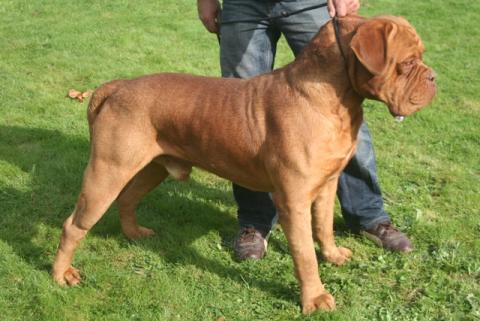Type the name of the breed you're looking for below
[wpdreams_ajaxsearchlite] Don't see the breed your're looking for? Click here and let us know!
Breed Characteristics
1 paw - breed exhibits the least amount of this characteristic
5 paws - breed exhibits most amount of this characteristic
Dogue de Bordeaux
| Other Names | Bordeaux Mastiff, French Mastiff, Bordeauxdog |
| Country of Origin | France |
| Weight | 120 - 145 lbs. (54.4 - 65.2 kg) |
| Height (at withers) | 23 - 30 in. (58 - 75 cm) |
| Coat | The coat is short and soft with loose fitting skin. |
| Colour | Colour varies from shades of fawn (light, coppery red) to mahogany (dark, brownish red) with a black, brown, or red mask, although the red mask is true to the breed. White markings are permitted on the tips of the toes and on the chest, but white on any other part of the body is considered a fault, and a disqualifying one if the pigmentation goes beyond the neck |
| Litter Size | 9 - 10 puppies |
| Life Span | 10 - 12 years |
| Origin & History | The Dogue de Bordeaux was known in France as early as the fourteenth century, particularly in southern France in the region around Bordeaux. Hence, the city lent its name to this large dog. A uniform breed type of the Bordeaux Dog did not exist before about 1920. The French placed emphasis on keeping the old breeding line pure. Black masks were considered an indication of the crossing in of the English Mastiff. As an important indication of purity of the breed, attention was paid to the self coloured (pink) nose, lighter eye color (dark amber), and red mask. They were originally bred with huge heads; a pioneer for the breed in Germany, Werner Preugschat once wrote: What am I supposed to do with a dog that has a monstrous skull and is at most able to carry it from the food dish to its bed? The Dogue de Bordeaux was at one time known to come in two varieties, Dogues and Doguins, the Dogue being considerably larger than the Dougin. The smaller Doguin has withered away to nothing more than a mention in breed history books, as it is no longer in existence. The history of the breed is believed to predate the Bullmastiff and the Bulldog. It is said that the Dogue can be found in the background of the Bullmastiff, and others claim that the Dogue and Mastiff breeds were both being accomplished at the same time. Another theory is the Dogue de Bordeaux originates from the Tibetan Mastiff and it is also said that the Dogue is related to the Greco Roman molossoids used for war. As there was a breed similar to the Dogue de Bordeaux in Rome at the time of Julius Caesar's reign, possibly a cousin of the Neapolitan Mastiff. Others suggest that the Dogue de Bordeaux is a descendent of a breed which existed in ancient France, the Dogues de Bordeaux of Aquitaine. Whichever theory is true, it is obvious that the Dogue de Bordeaux shares the same common links as all modern molossers. The Dogue de Bordeaux was once classified into three varieties, the Parisian, the Toulouse and the Bordeaux, types which were bred depending on the region of France and the jobs it was required to do. The ancestral Dogue de Bordeaux had various coat colors, such as brindle and a majority of white markings that carried fully up the legs. It had scissor bites in some regions, undershot in others; a big head or a small head, a large body or a small body; very inconsistent in type. Another controversial aspect was the mask, red (brown), none or black. The Dogue de Bordeaux of Bordeaux of the time also sported cropped ears. Regardless, it had a general type similar to today's Dogue de Bordeaux. |
| Personality | The Bordeaux has a good and calm temperament. It is extremely loyal, patient and devoted to his family. Fearless and confrontational with strangers, he is a first class watch and guard dog. Socialize very well with other animals, preferably starting from an early age to avoid him being aggressive with other dogs. The Dogue de Bordeaux snores and drools. Despite his fearsome appearance, the Dogue de Bordeaux is gentle with children and family members. However, this is a powerful animal, and is not suitable for an inexperienced dog owner. The objective in training this dog is to achieve pack leader status. It is a natural instinct for a dog to have an order in its pack. When we humans live with dogs, we become their pack. The entire pack cooperates under a single leader. Lines are clearly defined and rules are set. You and all other humans MUST be higher up in the order than the dog. That is the only way your relationship can be a success. This breed needs a calm, but firm owner who displays a natural authority over the dog. One who is confident and consistent. |
Care Requirements
| Health | Most are healthy, but the breed can be prone to hip dysplasia. There are also cases of epilepsy, heart problems and hyperkeratosis. Dams often have to have caesareans. |
| Grooming | Very little is needed. This breed is an average shedder. |
| Exercise | Needs lots of exercise. They need to be taken on a daily, long walk. Dogs that lack in mental and/or physical exercise can develop behavior issues. |
| Other Considerations | This breed will do okay in an apartment if it is sufficiently exercised. They are very inactive indoors and will do okay without a yard. |



